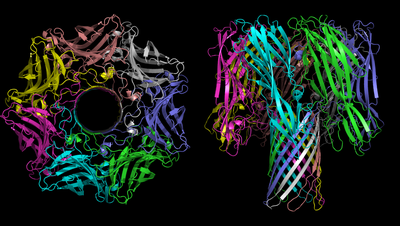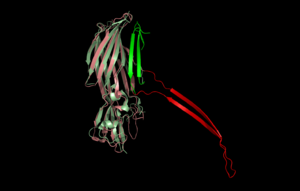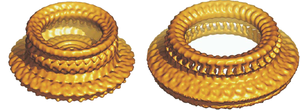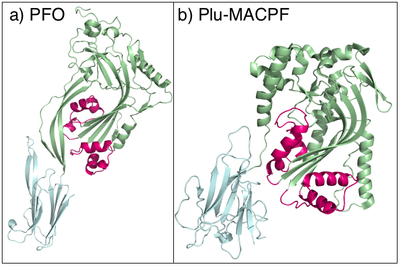
Pore forming toxins
Encyclopedia

Protein
Proteins are biochemical compounds consisting of one or more polypeptides typically folded into a globular or fibrous form, facilitating a biological function. A polypeptide is a single linear polymer chain of amino acids bonded together by peptide bonds between the carboxyl and amino groups of...
toxins, typically (but not exclusively), produced by bacteria
Bacteria
Bacteria are a large domain of prokaryotic microorganisms. Typically a few micrometres in length, bacteria have a wide range of shapes, ranging from spheres to rods and spirals...
, such as C.septicum
Clostridium septicum
Clostridium septicum is a gram positive, spore forming, obligate anaerobic bacterium.Clostridium septicum can cause gas gangrene, but unlike other Clostridium species like Clostridium perfringens, no trauma is necessary at the site of the infection. It is thought that the infection is established...
and S.aureus
Staphylococcus aureus
Staphylococcus aureus is a facultative anaerobic Gram-positive coccal bacterium. It is frequently found as part of the normal skin flora on the skin and nasal passages. It is estimated that 20% of the human population are long-term carriers of S. aureus. S. aureus is the most common species of...
. They are frequently cytotoxic (i.e., they kill cells
Cell (biology)
The cell is the basic structural and functional unit of all known living organisms. It is the smallest unit of life that is classified as a living thing, and is often called the building block of life. The Alberts text discusses how the "cellular building blocks" move to shape developing embryos....
), as they create unregulated pores
Ion channel
Ion channels are pore-forming proteins that help establish and control the small voltage gradient across the plasma membrane of cells by allowing the flow of ions down their electrochemical gradient. They are present in the membranes that surround all biological cells...
in the membrane
Cell membrane
The cell membrane or plasma membrane is a biological membrane that separates the interior of all cells from the outside environment. The cell membrane is selectively permeable to ions and organic molecules and controls the movement of substances in and out of cells. It basically protects the cell...
of targeted cells.
Types of PFTs
PFTs can be divided into the following subcategories:- Alpha-pore-forming toxins
- e.g., Cytolysin A of E. coli.
- Beta-pore-forming toxins
- e.g., α-HemolysinHemolysinHemolysins are exotoxins produced by bacteria that cause lysis of red blood cells in vitro. Visualization of hemolysis of red blood cells in agar plates facilitates the categorization of some pathogenic bacteria such as Streptococcus and Staphylococcus...
(Fig 1), PVL- Panton-Valentine leukocidinPanton-Valentine leukocidinPanton-Valentine leukocidin is a cytotoxin—one of the β-pore-forming toxins. The presence of PVL is associated with increased virulence of certain strains of Staphylococcus aureus...
.
- e.g., α-Hemolysin
Above are the two main distinctions of PFT's. They differ in the suspected mode of membrane integration, either by alpha-helical or beta-sheet elements.
Other Categories:
- Binary toxins
- e.g., AnthraxAnthraxAnthrax is an acute disease caused by the bacterium Bacillus anthracis. Most forms of the disease are lethal, and it affects both humans and other animals...
toxin
- e.g., Anthrax
- Cholesterol-dependent cytolysins (CDCs)
- e.g., PneumolysinPneumolysinPneumolysin is a putative virulence factor of the gram positive bacteria Streptococcus pneumoniae.It is a 53 kDa pore forming toxin composed of 471 amino acids...
- e.g., Pneumolysin
- Small pore-forming toxins
- e.g., GramicidinGramicidinGramicidin is a heterogeneous mixture of six antibiotic compounds, gramicidins A, B and C, making up 80%, 6%,and 14% respectively, all of which are obtained from the soil bacterial species Bacillus brevis and called collectively gramicidin D. Gramicidin D are linear pentadecapeptides; that is...
A
- e.g., Gramicidin
Beta-pore-forming toxins
β-PFTs are so-named because of their structural characteristics: They are composed mostly of β-strandBeta sheet
The β sheet is the second form of regular secondary structure in proteins, only somewhat less common than the alpha helix. Beta sheets consist of beta strands connected laterally by at least two or three backbone hydrogen bonds, forming a generally twisted, pleated sheet...
-based domains. Whilst they frequently have divergent sequences, X-ray crystallographic structures
X-ray crystallography
X-ray crystallography is a method of determining the arrangement of atoms within a crystal, in which a beam of X-rays strikes a crystal and causes the beam of light to spread into many specific directions. From the angles and intensities of these diffracted beams, a crystallographer can produce a...
have revealed some commonalities: α-haemolysin and Panton-Valentine leukocidin
Panton-Valentine leukocidin
Panton-Valentine leukocidin is a cytotoxin—one of the β-pore-forming toxins. The presence of PVL is associated with increased virulence of certain strains of Staphylococcus aureus...
S are structurally related, as are aerolysin
Aerolysin
In molecular biology, aerolysin is a cytolytic toxin exported by Aeromonas hydrophila, a Gram-negative bacterium associated with diarrhoeal diseases and deep wound infections. The mature toxin binds to eukaryotic cells and aggregates to form holes leading to the destruction of the membrane...
and Clostridial Epsilon-toxin.
Mode of action

Hemolysin
Hemolysins are exotoxins produced by bacteria that cause lysis of red blood cells in vitro. Visualization of hemolysis of red blood cells in agar plates facilitates the categorization of some pathogenic bacteria such as Streptococcus and Staphylococcus...
, the only crystal structure of a β-PFT in its pore-form to-date. 7 α-Hemolysin monomers come together to create the mushroom
Mushroom
A mushroom is the fleshy, spore-bearing fruiting body of a fungus, typically produced above ground on soil or on its food source. The standard for the name "mushroom" is the cultivated white button mushroom, Agaricus bisporus; hence the word "mushroom" is most often applied to those fungi that...
-shaped pore. The 'cap' of the mushroom sits on the surface of the cell, and the 'stalk' of the mushroom penetrates the cell membrane, rendering it permeable (see later).
The 'stalk' is composed of a 14-strand β-barrel
Beta barrel
A beta barrel is a large beta-sheet that twists and coils to form a closed structure in which the first strand is hydrogen bonded to the last.Beta-strands in beta-barrels are typically arranged in an antiparallel fashion...
, with two strands donated from each monomer. The Panton-Valentine Leucocidin S structure (PDB 1T5R) shows a highly related structure, but in its soluble monomeric state. This shows that the strands involved in forming the 'stalk' are in a very different conformation
Chemical structure
A chemical structure includes molecular geometry, electronic structure and crystal structure of molecules. Molecular geometry refers to the spatial arrangement of atoms in a molecule and the chemical bonds that hold the atoms together. Molecular geometry can range from the very simple, such as...
- shown in Fig 2.
Assembly
The transition between soluble monomer and membrane-associated protomer
Protomer
In structural biology, a protomer is the structural unit of an oligomeric protein. A protomer can be a protein subunit or several different subunits, that assemble in a defined stoichiometry to form an oligomer. The protomer is the smallest subset of different subunits that form the oligomer. The...
to oligomer is not a trivial one: It is believed that β-PFTs, follow as similar assembly pathway as the CDCs (see Cholesterol-dependent cytolysins
Pore forming toxins
Pore-forming toxins are protein toxins, typically , produced by bacteria, such as C.septicum and S.aureus. They are frequently cytotoxic , as they create unregulated pores in the membrane of targeted cells.-Types of PFTs:PFTs can be divided into the following subcategories:* Alpha-pore-forming...
later), in that they must first assemble on the cell-surface (in a receptor-mediated fashion in some cases) in a pre-pore state. Following this, the large-scale conformational change occurs in which the membrane spanning section is formed and inserted into the membrane. The portion entering the membrane, referred to as the head, is usually apolar and hydrophobic, this produces an energetically favorable insertion of the Pore-forming toxin.
Specificity
Some β-PFTs such as clostridial ε-toxin and Clostridium perfringensClostridium perfringens
Clostridium perfringens is a Gram-positive, rod-shaped, anaerobic, spore-forming bacterium of the genus Clostridium. C. perfringens is ever present in nature and can be found as a normal component of decaying vegetation, marine sediment, the intestinal tract of humans and other vertebrates,...
Enterotoxin (CPE) bind to the cell membrane via specific receptors - possibly certain claudin
Claudin
Claudins are a family of proteins that are the most important components of the tight junctions, where they establish the paracellular barrier that controls the flow of molecules in the intercellular space between the cells of an epithelium...
s for CPE, possibly GPI anchors
Glycophosphatidylinositol
Glycosylphosphatidylinositol is a glycolipid that can be attached to the C-terminus of a protein during posttranslational modification...
or other sugars for ε-toxin - these receptors help raise the local concentration of the toxins, allowing oligomerisation and pore formation.
The Cyto-lethal effects of the pore
When the pore is formed, the tight regulation of what can and cannot enter/leave a cell is disrupted. Ions and small molecules, such as amino acids and nucleotides within the cell, flow out, and water from the surrounding tissue enters. The loss of important small molecules to the cell can disrupt protein synthesis and other crucial cellular reactions. The loss of ions, especially calciumCalcium
Calcium is the chemical element with the symbol Ca and atomic number 20. It has an atomic mass of 40.078 amu. Calcium is a soft gray alkaline earth metal, and is the fifth-most-abundant element by mass in the Earth's crust...
, can cause cell signaling
Cell signaling
Cell signaling is part of a complex system of communication that governs basic cellular activities and coordinates cell actions. The ability of cells to perceive and correctly respond to their microenvironment is the basis of development, tissue repair, and immunity as well as normal tissue...
pathways to be spuriously activated or deactivated. The uncontrolled entry of water into a cell can cause the cell to swell up uncontrollably: This causes a process called blebbing, wherein large parts of the cell membrane are distorted and give way under the mounting internal pressure. In the end, this can cause the cell to burst.
Binary toxins
See the main article for more information on Anthrax toxinAnthrax toxin
Anthrax toxin is a three-protein exotoxin secreted by virulent strains of the bacterium, Bacillus anthracis--the causative agent of anthrax. The toxin was first discovered by Harry Smith in 1954. Anthrax toxin is composed of a cell-binding protein, known as protective antigen , and two enzyme...
s.
Binary toxins, such as Anthrax
Anthrax
Anthrax is an acute disease caused by the bacterium Bacillus anthracis. Most forms of the disease are lethal, and it affects both humans and other animals...
lethal & edema toxins, C.perfringens
Clostridium perfringens
Clostridium perfringens is a Gram-positive, rod-shaped, anaerobic, spore-forming bacterium of the genus Clostridium. C. perfringens is ever present in nature and can be found as a normal component of decaying vegetation, marine sediment, the intestinal tract of humans and other vertebrates,...
Iota toxin and C.difficile
Clostridium difficile
Clostridium difficile , also known as "CDF/cdf", or "C...
cyto-lethal toxins consist of two components (hence binary):
- an enzymaticEnzymeEnzymes are proteins that catalyze chemical reactions. In enzymatic reactions, the molecules at the beginning of the process, called substrates, are converted into different molecules, called products. Almost all chemical reactions in a biological cell need enzymes in order to occur at rates...
component - A - a membraneCell membraneThe cell membrane or plasma membrane is a biological membrane that separates the interior of all cells from the outside environment. The cell membrane is selectively permeable to ions and organic molecules and controls the movement of substances in and out of cells. It basically protects the cell...
-altering component - B
The B component facilitates the entry of the enzymatic 'payload' into the target cell
Cell (biology)
The cell is the basic structural and functional unit of all known living organisms. It is the smallest unit of life that is classified as a living thing, and is often called the building block of life. The Alberts text discusses how the "cellular building blocks" move to shape developing embryos....
, by forming homooligomeric pores, as shown above for βPFTs. The A component then enters the cytosol
Cytosol
The cytosol or intracellular fluid is the liquid found inside cells, that is separated into compartments by membranes. For example, the mitochondrial matrix separates the mitochondrion into compartments....
and inhibits normal cell functions by one of the following means:
Mono-ADP-Ribosylation of G-actin
ADP-Ribosylation is a common enzymatic methods used by various bacterial toxins from various species. These toxins (including C.perfringensClostridium perfringens
Clostridium perfringens is a Gram-positive, rod-shaped, anaerobic, spore-forming bacterium of the genus Clostridium. C. perfringens is ever present in nature and can be found as a normal component of decaying vegetation, marine sediment, the intestinal tract of humans and other vertebrates,...
Iota toxin & C.Botulinum
Clostridium botulinum
Clostridium botulinum is a Gram-positive, rod-shaped bacterium that produces several toxins. The best known are its neurotoxins, subdivided in types A-G, that cause the flaccid muscular paralysis seen in botulism. It is also the main paralytic agent in botox. C. botulinum is an anaerobic...
C2 toxin) attach a ribosyl-ADP moiety to surface Arginine
Arginine
Arginine is an α-amino acid. The L-form is one of the 20 most common natural amino acids. At the level of molecular genetics, in the structure of the messenger ribonucleic acid mRNA, CGU, CGC, CGA, CGG, AGA, and AGG, are the triplets of nucleotide bases or codons that codify for arginine during...
residue 177 of G-actin. This prevents G-actin assembling to form F-actin, and, thus, the cytoskeleton
Cytoskeleton
The cytoskeleton is a cellular "scaffolding" or "skeleton" contained within a cell's cytoplasm and is made out of protein. The cytoskeleton is present in all cells; it was once thought to be unique to eukaryotes, but recent research has identified the prokaryotic cytoskeleton...
breaks down, resulting in cell death.
Proteolysis of Mitogen-activated protein kinase kinases (MAPKK)
The A component of Anthrax toxinAnthrax toxin
Anthrax toxin is a three-protein exotoxin secreted by virulent strains of the bacterium, Bacillus anthracis--the causative agent of anthrax. The toxin was first discovered by Harry Smith in 1954. Anthrax toxin is composed of a cell-binding protein, known as protective antigen , and two enzyme...
lethal toxin is zinc
Zinc
Zinc , or spelter , is a metallic chemical element; it has the symbol Zn and atomic number 30. It is the first element in group 12 of the periodic table. Zinc is, in some respects, chemically similar to magnesium, because its ion is of similar size and its only common oxidation state is +2...
-metalloprotease
Protease
A protease is any enzyme that conducts proteolysis, that is, begins protein catabolism by hydrolysis of the peptide bonds that link amino acids together in the polypeptide chain forming the protein....
, which shows specificity for a conserved family of Mitogen-activated protein kinase kinases
Mitogen-activated protein kinase
Mitogen-activated protein kinases are serine/threonine-specific protein kinases that respond to extracellular stimuli and regulate various cellular activities, such as gene expression, mitosis, differentiation, proliferation, and cell survival/apoptosis.-Activation:MAP kinases are activated...
. The loss of these proteins results in a breakdown of cell signaling, which, in turn, renders the cell insensitive to outside stimuli - therefore no immune response is triggered.
Increasing intracellular levels of cAMP
Anthrax toxinAnthrax toxin
Anthrax toxin is a three-protein exotoxin secreted by virulent strains of the bacterium, Bacillus anthracis--the causative agent of anthrax. The toxin was first discovered by Harry Smith in 1954. Anthrax toxin is composed of a cell-binding protein, known as protective antigen , and two enzyme...
Edema toxin triggers a calcium
Calcium
Calcium is the chemical element with the symbol Ca and atomic number 20. It has an atomic mass of 40.078 amu. Calcium is a soft gray alkaline earth metal, and is the fifth-most-abundant element by mass in the Earth's crust...
ion influx into the target cell. This subsequently elevates intracellular cAMP levels. This can profoundly alter any sort of immune response, by inhibiting leucocyte
Leucocyte
Leucocyte may refer to:*White blood cells*Leucocyte , a 2008 album by the jazz band E.S.T....
proliferation, phagocytosis, and proinflammatory
Inflammation
Inflammation is part of the complex biological response of vascular tissues to harmful stimuli, such as pathogens, damaged cells, or irritants. Inflammation is a protective attempt by the organism to remove the injurious stimuli and to initiate the healing process...
cytokine
Cytokine
Cytokines are small cell-signaling protein molecules that are secreted by the glial cells of the nervous system and by numerous cells of the immune system and are a category of signaling molecules used extensively in intercellular communication...
release.
Cholesterol-dependent cytolysins

Streptococcus pneumoniae
Streptococcus pneumoniae, or pneumococcus, is Gram-positive, alpha-hemolytic, aerotolerant anaerobic member of the genus Streptococcus. A significant human pathogenic bacterium, S...
, form pores as large as 260Å (26 nm), containing between 30 and 44 monomer units. Electron Microscopy studies of Pneumolysin show that it assembles into large multimeric peripheral membrane
Peripheral membrane protein
Peripheral membrane proteins are proteins that adhere only temporarily to the biological membrane with which they are associated. These molecules attach to integral membrane proteins, or penetrate the peripheral regions of the lipid bilayer. The regulatory protein subunits of many ion channels and...
complexes before undergoing a conformational change in which a group of α-helices
Alpha helix
A common motif in the secondary structure of proteins, the alpha helix is a right-handed coiled or spiral conformation, in which every backbone N-H group donates a hydrogen bond to the backbone C=O group of the amino acid four residues earlier...
in each monomer change into extended, amphipathic β-hairpins
Beta hairpin
The beta hairpin structural motif is the simplest protein motif involving two beta strands that look like a hairpin. The motif consists of two strands that are adjacent in primary structure oriented in an antiparallel arrangement and linked by a short loop of two to five amino acids...
that span the membrane, in a manner reminiscent of α-haemolysin, albeit on a much larger scale (Fig 3). CDCs are homologous to the MACPF
MACPF
The MACPF protein superfamily is named after a domain that is common to the Membrane Attack Complex proteins of complement and perforin . Many members of this protein family are important eukaryote pore forming toxins....
family of pore-forming toxins, and it is suggested that both families utilise a common mechanism (Fig 4).http://www.rcsb.org/pdb/explore/explore.do?structureId=2QP2 Eukaryote MACPF
MACPF
The MACPF protein superfamily is named after a domain that is common to the Membrane Attack Complex proteins of complement and perforin . Many members of this protein family are important eukaryote pore forming toxins....
proteins function in immune defence and are found in proteins such as perforin and complement C9.

Purpose
Bacteria invest much time and energy in making these toxins: CPE can account for up to 15% of the dry mass of C.perfringens at the time of sporulation. The purpose of toxins is thought to be one of the following:- Defense against phagocytosis, e.g., by a macrophageMacrophageMacrophages are cells produced by the differentiation of monocytes in tissues. Human macrophages are about in diameter. Monocytes and macrophages are phagocytes. Macrophages function in both non-specific defense as well as help initiate specific defense mechanisms of vertebrate animals...
. - Inside a hostHost (biology)In biology, a host is an organism that harbors a parasite, or a mutual or commensal symbiont, typically providing nourishment and shelter. In botany, a host plant is one that supplies food resources and substrate for certain insects or other fauna...
, provoking a response which is beneficial for the proliferation of the bacteria, for example in choleraCholeraCholera is an infection of the small intestine that is caused by the bacterium Vibrio cholerae. The main symptoms are profuse watery diarrhea and vomiting. Transmission occurs primarily by drinking or eating water or food that has been contaminated by the diarrhea of an infected person or the feces...
. - Food: After the target cell has ruptured and released its contents, the bacteria can scavenge the remains for nutrients.
- Environment: The mammalian immune response helps create the anaerobicHypoxia (environmental)Hypoxia, or oxygen depletion, is a phenomenon that occurs in aquatic environments as dissolved oxygen becomes reduced in concentration to a point where it becomes detrimental to aquatic organisms living in the system...
environment that anaerobic bacteria require.
Further reading
- F. Gisou van der Goot, Pore-forming toxins, Springer, 2001, ISBN 3540413863

